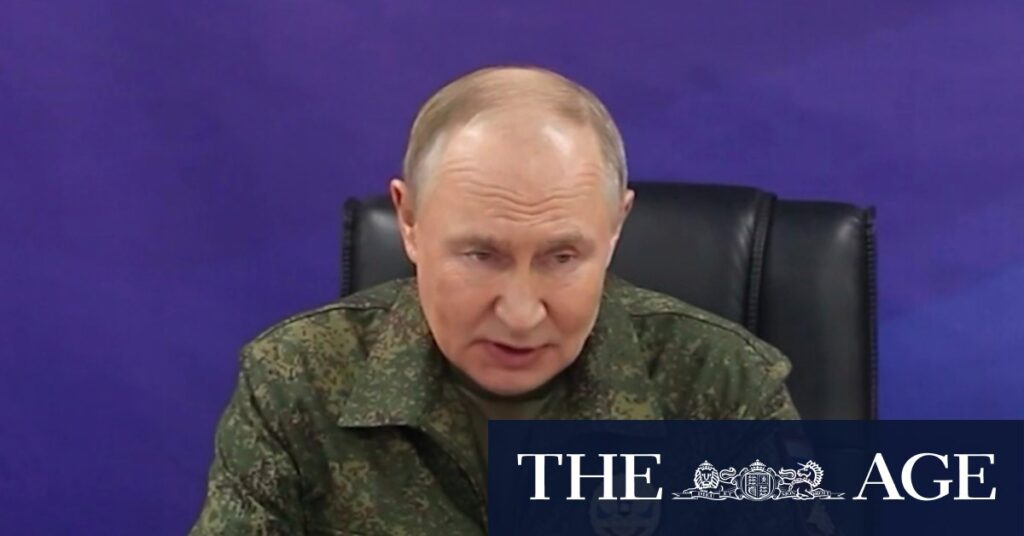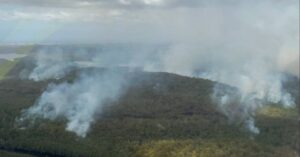
Moscow: Russia has successfully tested a new nuclear-capable and powered cruise missile, the Burevestnik, which President Vladimir Putin claims can evade existing defense systems. The announcement, made on Sunday, marks a significant step towards deploying this advanced weapon in Russia’s military arsenal.
The test, which follows years of development, comes amid heightened nuclear rhetoric from the Kremlin. Russia has been resisting Western pressure for a ceasefire in Ukraine and has issued stern warnings to the United States and NATO allies against using longer-range Western weapons for strikes deep inside Russian territory.
Details of the Burevestnik Test
A video released by the Kremlin shows President Putin, clad in camouflage, receiving a report from General Valery Gerasimov, Russia’s chief of general staff. Gerasimov reported that the Burevestnik covered an impressive 14,000 kilometers in a key test conducted on Tuesday, staying airborne for 15 hours on nuclear power. He noted, “that’s not the limit.”
Putin responded by highlighting the missile’s uniqueness, stating, “This is a unique product that no one in the world has. We need to identify potential uses and begin preparing the infrastructure for deploying this weapon in our armed forces.” The Russian leader also claimed that the missile’s almost unlimited range and unpredictable flight path make it invulnerable to current and future missile defenses.
Expert Opinions and Concerns
Despite the successful test, the Burevestnik, codenamed Skyfall by NATO, has been met with skepticism from Western experts. Jeffrey Lewis, a nuclear nonproliferation expert at Middlebury College in the US, described it as “a tiny flying Chernobyl,” referencing the catastrophic nuclear accident that occurred in 1986. Lewis warned, “This is a bad development. It is one more science-fiction weapon that is going to be destabilizing and hard to address in arms control.”
Many observers argue that such a missile could be challenging to manage and pose significant environmental risks. Both the US and the former Soviet Union explored nuclear-powered missiles during the Cold War but eventually abandoned the projects due to their hazardous nature.
Historical Context and Previous Incidents
The Burevestnik program has not been without its setbacks. In August 2019, an explosion during tests at a navy range on the White Sea in north-west Russia killed at least five nuclear engineers and two service members, causing a brief spike in radioactivity. Although Russian officials did not identify the weapon involved, the US attributed the incident to the Burevestnik.
Despite these challenges, Moscow appears committed to advancing the program. The International Institute for Strategic Studies notes that the Burevestnik has been tested at three sites in western Russia: Kapustin Yar, Nenoksa, and Pankovo. The US intelligence community first identified the project at the Kapustin Yar missile range, suggesting that development has likely been ongoing for over a decade.
Strategic Implications and Future Prospects
The successful test of the Burevestnik aligns with Russia’s broader strategic objectives. In the past week, Putin directed drills of Russia’s strategic nuclear forces, which included practice missile launches and involved all parts of Moscow’s nuclear triad. These exercises, which also featured Tu-95 strategic bombers firing long-range cruise missiles, underscore Russia’s commitment to maintaining a formidable nuclear deterrent.
Kirill Dmitriev, a top aide to Putin, informed American colleagues of the “successful testing” of the Burevestnik, describing it as an “absolutely new class” of weapon. The move represents a potential bargaining chip in any future arms-control discussions, although it remains to be seen whether the focus will be on overcoming technical difficulties or leveraging the missile’s capabilities in negotiations.
As the international community grapples with the implications of this development, the Burevestnik’s successful test raises critical questions about the future of nuclear arms control and the balance of power. The world will be watching closely as Russia continues to refine and potentially deploy this groundbreaking weapon.







